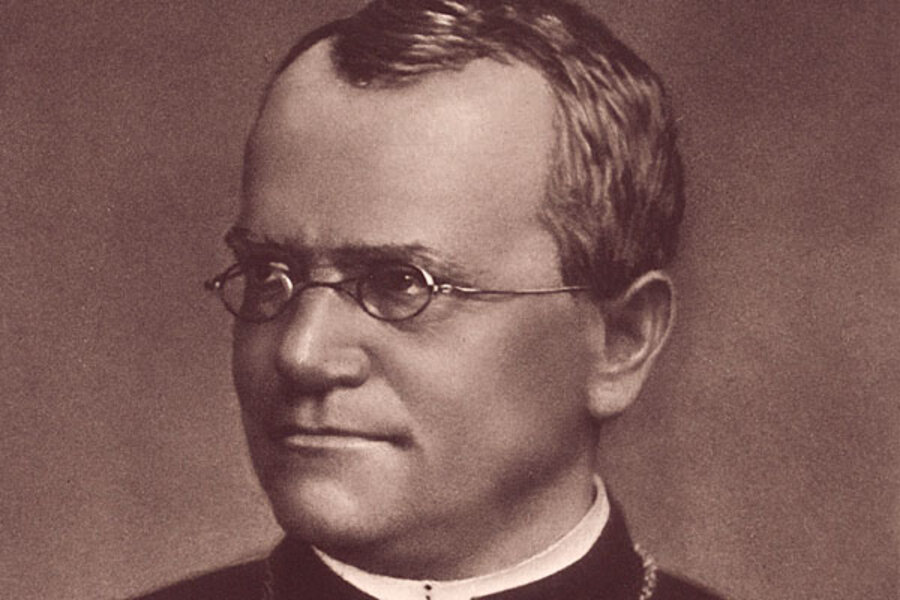Why you should care about Gregor Mendel
Loading...
Google's logo today commemorates the 189th birthday of Gregor Mendel, the Moravian monk who is widely regarded as the Father of Genetics.
You might remember from high school biology class that Mendel mucked about with peas, and that he came up with the concept of dominant and recessive traits. But why, exactly, is any of this important in 2011?
Because without Mendel's contributions, Charles Darwin's theory of evolution would make no sense. In his 1859 book "The Origin of Species," Darwin postulated that species evolve by means of mutation and natural selection. For example, an antelope-like creature with a slightly longer neck will be able to dine on leaves that are unreachable by her peers. This advantage will make her more likely to survive into adulthood and to have more offspring, who are themselves more likely to have inherited their mother's longer neck. Eventually, over thousands of generations, the trait for longer necks spreads through the population, and they gradually become giraffes.
So far, so good. But in Darwin's time, nobody understood how traits were inherited. The dominant belief back then was that inherited traits blended together. Under this model, the daughter of a long-necked mother and a normal-necked father will be only somewhat longish necked. And when that somewhat-longish-necked daughter mates with a normal-necked male, their offspring will be only a little bit long-necked, and so on through the generations until the trait is diluted away.
As the great Scottish polymath Fleeming Jenkins argued in his 1867 takedown of Darwin's theory, "We have abnormal variations called sports, which may be supposed to introduce new organs or habits in rare individuals. This case must be again subdivided; we may suppose the offspring of the sports to be intermediate between their ancestor and the original tribe. In this case the sport will be swamped by numbers, and after a few generations its peculiarity will be obliterated."
As Darwin struggled to reconcile his observations with the theory of blending inheritance, some 800 miles away in Brno (part of what is now the Czech Republic), Mendel was working on a solution. Trained in physics, the Augustinian monk brought his considerable skills in statistical analysis to bear on his cultivation of 29,000 pea plants, which he grew in an experimental garden on the grounds of his monastery.
Mendel noticed that the plants' traits did not blend together: a pea plant with yellow pods cross-pollinated with one with green pods plant did not result in yellowish-green pods, as would have been expected. Instead, every single pea in the first generation crop remained yellow. But then when Mendel self-pollinated that crop, some plants in the the second generation went back to being green, while most of them remained yellow, always in a 3:1 ratio. Mendel realized that inherited traits remained intact through generations, carried by what he called "factors." (Mendel never used the word "gene," which wasn't coined until 1913.)
Mendel's library of 20,000 books included a copy of Darwin's "Origin," but Mendel never seemed to connect his discoveries with the theory of evolution.
For his part, Darwin himself came tantalizingly close to repeating Mendel's discoveries. In 1866, the same year that Mendel published his theory of particulate inheritance, Darwin was experimenting on his own – with pea plants no less.
This 2003 Guardian article by British biologist Richard Dawkins quotes a letter, discovered by chance in the British Library, from Darwin to his colleague Alfred Wallace, in which Darwin writes, "I crossed the Painted Lady and Purple sweetpeas, which are very differently coloured varieties, and got, even out of the same pod, both varieties perfect but none intermediate."
But Darwin didn't take this discovery much further, even though his 1876 book, "The Effects of Cross and Self Fertilisation in the Vegetable Kingdom," covered much of the same ground that Mendel had covered.
Mendel died in 1884, and just sixteen years later his work was rediscovered independently by scientists Hugo de Vries and Carl Correns. It wasn't until the 1930s and 40s, however, that biologists connected Mendel's observations to Darwin's theory, creating the so-called Modern Synthesis that is the currently accepted model in evolutionary biology.





